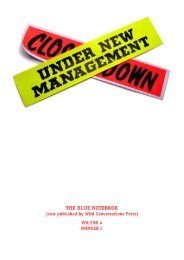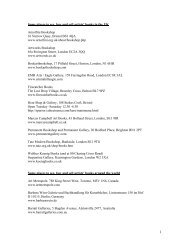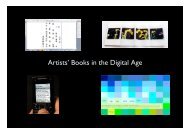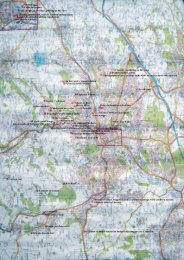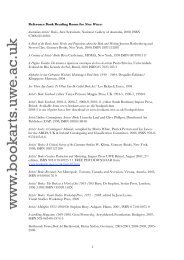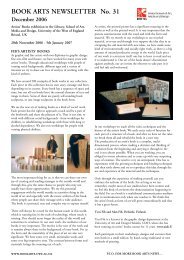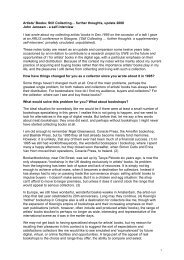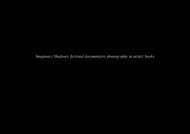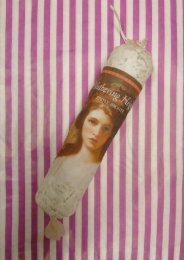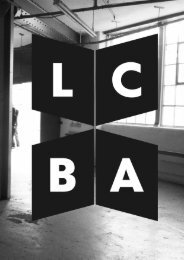Artist's Book Yearbook 2003-2005 - Book Arts - University of the ...
Artist's Book Yearbook 2003-2005 - Book Arts - University of the ...
Artist's Book Yearbook 2003-2005 - Book Arts - University of the ...
Create successful ePaper yourself
Turn your PDF publications into a flip-book with our unique Google optimized e-Paper software.
natural organism. As a consequence <strong>the</strong> choice<br />
<strong>of</strong> <strong>the</strong> <strong>the</strong>me for <strong>the</strong> annual production evolves<br />
from <strong>the</strong> experiences <strong>of</strong> <strong>the</strong> previous year. For<br />
example <strong>the</strong>mes have been : Das Plagiat<br />
(plagiarism): 20 artists copying each o<strong>the</strong>r,<br />
every copy being <strong>the</strong> original for <strong>the</strong> next one<br />
in line; Das Unsägliche (unspeakable):<br />
I write a text for your picture / you illustrate<br />
my text (involving 19 artists); Das Gastmahl<br />
(<strong>the</strong> banquet): 17 artists were invited to eat<br />
and drink and make art and read Platon’s<br />
Symposium, resulting in a series <strong>of</strong> one-<strong>of</strong>a-kind<br />
artists’ books; Exerzitien (religious<br />
exercises): 18 artists spent a week toge<strong>the</strong>r in<br />
complete silence in a monastery, only<br />
communicating by exchanging pictures drawn<br />
into “cell books”.<br />
The illustrations (opposite) show samples from<br />
Frankfurter Edition’s latest project: Im Städel<br />
(At <strong>the</strong> Städel-Museum) art about art. Fifteen<br />
artists investigated selected items <strong>of</strong> <strong>the</strong><br />
Museum <strong>of</strong> Fine Art in Frankfurt, resulting in a<br />
collection <strong>of</strong> contemporary responses to<br />
classical paintings <strong>of</strong> <strong>the</strong> 17th to 20th century,<br />
here especially works that all deal with<br />
Courbet’s The Wave.<br />
Hartmut Andryczuk is artist, author, publisher<br />
and journalist all in one. He is especially<br />
interested in book arts’ networks, artists’<br />
magazines networks, and, <strong>of</strong> course, <strong>the</strong><br />
internet as a platform for literature and fine<br />
arts. For 10 years, his Hybriden Verlag has been a<br />
forum for contemporary experimental artists’<br />
books with contributions by Pierre Garnier,<br />
Valeri Scherstjanoi, Wolfgang Müller and<br />
o<strong>the</strong>rs. Often Hartmut Andryczuk invites artists<br />
to work on a certain subject, such as Schädlingsbekämpfung/pest<br />
control or Virenbiblio<strong>the</strong>k.<br />
He <strong>of</strong>ten collaborates with artists and authors<br />
such as Freddy Flores Knist<strong>of</strong>f or Felix Martin<br />
Furtwängler and publishes some different sorts<br />
<strong>of</strong> magazines (periodicals): Unikatmaschine,<br />
MMM-Diarium, Hybridenland. Works include<br />
texts, sculptures, installations, performances,<br />
audio-CDs, and editions which document<br />
what’s happening and continue to explore <strong>the</strong><br />
results.<br />
Uta Schneider is an artist especially interested<br />
in collaboration. Ra<strong>the</strong>r than monologues in<br />
self-assertion <strong>the</strong> interest in artistic dialogue<br />
62<br />
becomes important. Jeder wusste um was es ging<br />
(Everybody knew what it was all about) is <strong>the</strong><br />
result <strong>of</strong> one <strong>of</strong> <strong>the</strong>se artistic dialogues: a<br />
collaboration <strong>of</strong> Uta Schneider with <strong>the</strong> painter<br />
Thomas Dahmen. The book consists <strong>of</strong> three<br />
parts with <strong>the</strong> <strong>the</strong>mes lines, planes, and figures,<br />
all printed from linocuts, woodcuts and<br />
cardboard cuts. Each part was printed page<br />
after page starting with <strong>the</strong> first page; <strong>the</strong><br />
translucent paper connects not only <strong>the</strong> open<br />
double spread but also <strong>the</strong> pages following.<br />
Jeder wusste um was es ging Uta Schneider / Thomas Dahmen<br />
Every page is <strong>the</strong> result <strong>of</strong> what has been<br />
printed before and influences <strong>the</strong> next pages.<br />
Hand set texts were added and printed in<br />
white, as <strong>the</strong> text should not be in <strong>the</strong><br />
foreground, but ra<strong>the</strong>r be a commentary voice<br />
in <strong>the</strong> background. The book can be read as<br />
a visual essay on perception: how do forms and<br />
figures influence each o<strong>the</strong>r, how are image<br />
and text related to one ano<strong>the</strong>r? - <strong>the</strong>se are<br />
some <strong>of</strong> <strong>the</strong> questions <strong>the</strong> book deals with.<br />
Liegend/Im Fall uses a text by Uwe Warnke, with<br />
whom Uta Schneider has done a few o<strong>the</strong>r<br />
books as well. Here, <strong>the</strong> text, which consists<br />
only <strong>of</strong> one sentence (which I think is a<br />
speciality <strong>of</strong> <strong>the</strong> German language!) leads to<br />
<strong>the</strong> structure <strong>of</strong> <strong>the</strong> book: From colon to colon,<br />
<strong>the</strong> text is cut into 49 parts. Each part <strong>of</strong> <strong>the</strong><br />
text is printed onto <strong>the</strong> middle <strong>of</strong> a square<br />
sheet <strong>of</strong> transparent paper, with overlapping<br />
elements <strong>of</strong> illustrations. The 49 squares make<br />
up one big square <strong>of</strong> 7 x 7 sheets, thus giving<br />
one image and <strong>the</strong> text in its proper order.




